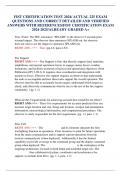FIST CERTIFICATION TEST 2024/ ACTUAL 225 EXAM
QUESTIONS AND CORRECT DETAILED AND VERIFIED
ANSWERS WITH REFERENCES/FIST CERTIFICATION EXAM
2024-2025/ALREADY GRADED A+
True / False: The FDC announces "SPLASH" to the observer 5 seconds prior
to round impact. The observer then announces SPLASH out, the observer
does not wait to see the impact to announce SPLASH out.
RIGHT ANS :->>> - True. (pg.4-8, para.4-63)
Fire Support
RIGHT ANS:->>> - Fire Support is fires that directly support land, maritime,
amphibious, and special operations forces to engage enemy forces, combat
formations, and facilities in pursuit of tactical and operational objectives (Joint
Publication [JP] 3-09.3). It requires close coordination and integration with
maneuver forces. Effective fire support requires an observer that understands
the tasks to accomplish and how these tasks support the overall operation. The
observer must be able to accurately locate targets, understand which targets to
attack, and effectively communicate what he sees to the rest of the fire support
community. ( pg. 1-1)
What are the 5 requirements for achieving accurate first-round fire for effect?
RIGHT ANS:->>> - These five requirements for accurate predicted fires are:
accurate target location and size, firing unit location, weapon and ammunition
information, meteorological information, and computational procedures. The
observer is solely responsible for the first requirement. (pg. 1-1 para. 1-1)
Fires Cell
RIGHT ANS:->>> - The and its elements integrate the fires
warfighting function in operations. It has resources to plan for future operations
from the main command post and to support current operations from the
tactical command post (when deployed). Additionally it has the limited
capability to provide coverage to the command group and the deputy command
group when deployed. The is the centerpiece of the
targeting architecture, focused on both lethal and nonlethal target sets. The
thus collaboratively plans, coordinates and synchronizes fire
support, to include Joint Fires. (pg. 1-1, para. 1-3)
,Who has the responsibility to integrate fire support with the scheme of
maneuver? Who translates the guidance into fire support tasks?
RIGHT ANS:->>> - The
has the responsibility to integrate fire support with the
scheme of maneuver. He provides the commander's intent for an operation and
issues guidance, including guidance for fire support. The
translates the guidance into fire support tasks. Each fire support task and
purpose directly supports a maneuver task and purpose. Then assigns
responsibility of tasks in the Fire Support Plan, assets, and priority of fires, to
the observers using all available assets. Ensures dissemination of FS products to
all supporting assets. (pg. 1-6, para. 1-24)
Target of Opportunity
RIGHT ANS:->>> - A target identified too late, or not selected for action in
time, to be included in deliberate targeting that, when detected or located, meets
criteria specific to achieving objectives and is processed using dynamic
targeting.
***5 target types: facility, individual(s), virtual, equipment, organization
(pg. 1-7, para.1-27)
Planned Target
RIGHT ANS:->>> - A is a target that is known to exist in
the operational environment, upon which actions are planned using deliberate
targeting, creating effects which support commander's objectives.
*** Scheduled and On-Call
Targets (pg. 1-7, para. 1-28)
Scheduled Target
RIGHT ANS:->>> - A is a planned target upon which
fires or other actions are scheduled for prosecution at a specified time.
(pg. 1-7, para. 1-28)
,On-Call Target
RIGHT ANS:->>> - A target is a planned target upon which
fires or other actions are determined using deliberate targeting and triggered,
when detected or located, using dynamic targeting.
(pg. 1-7, para. 1-7)
Priority Target
RIGHT ANS:->>> - A is a target on which the delivery
of fires takes precedence over all the fires for the designated firing unit or
element.
(pg.1-7, para. 1-29)
Final Protective Fire (FPF)
RIGHT ANS:->>> - is an immediately
available prearranged barrier of fire designed to impede enemy movement
across defensive lines or areas.
(pg. 1-7, para.1-30)
Group of Targets
RIGHT ANS:->>> - A consists of two or more
targets on which fire is desired simultaneously.
(pg. 1-11, para. 1-41)
Series of Targets
RIGHT ANS:->>> - A is a number of targets or
group(s) of targets planned to be fired in a predetermined sequence to support a
maneuver operation. (pg. 1-12, para. 1-42)
Program of Targets
RIGHT ANS:->>> - A consists of a number of
planned targets of a similar nature that are planned for sequential attack.
(pg. 1-12, para. 1-43)
Fire Support Planning
RIGHT ANS:->>> - is accomplished using
targeting and the running estimate. It includes developing integrated fire plans
, (target lists, fire support execution/fire support task matrix, scheme of fires,
and overlays) and determining forward observer control options that support the
commander's scheme of maneuver.
(pg. 2-2, para. 2-4)
Fire Support Coordination
RIGHT ANS:->>> - is the
planning and executing of fire so that targets are adequately covered by a
suitable weapon or group of weapons (JP 3-09).The FIST must maintain
situational understanding at all times and monitor voice requests for fire
support within the maneuver element to prevent fratricide as the result of
friendly fire support. The FIST must advise the commander on any fire support
coordination measures (FSCM) in effect.
(pg.2-2, para. 2-5)
What does the memory aid FA-PARCA mean?
RIGHT ANS:->>> - In order to develop an effective fire support plan, the FSO
must understand the fires planning process and address all the essential elements
of a fire support plan. To help ensure allconsiderations are addressed, the FSO
uses the memory aid FA-PARCA, which means—
Fire, Allocation, Positioning, Attack, Restrictions, Coordinating,
Assessment. (pg.2-4, para. 2-21)
For Occupying a observation post, what is the mils and radius of the
reconnaissance security sweep?
RIGHT ANS:->>> - 6400mils for 500m radius around the observation post.
(pg. 2-13, para. 2-69)
Occupying an observation post using SLOCTOP; Identify the item that is not
part of L-Location? RIGHT ANS:->>> -
Occupying an observation post using SLOCTOP; what is the number one
priority for the team? RIGHT ANS:->>> - Communication (pg.2-13, para. 2-76)





